Why Are My Geraniums Dying – What Should I Be Doing?
There could be many reasons for a geranium to die. For instance, improper watering, unfit soil, over/under fertilization, bacterial infection, or fungal growth. Each problem has its own unique fix as well.
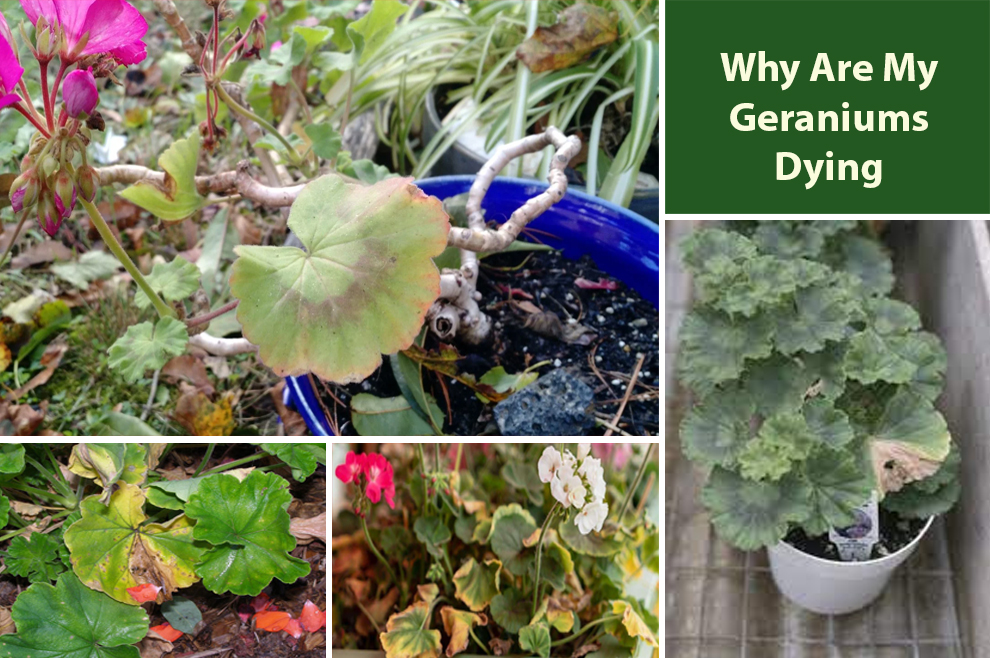
Geraniums are an easy-to-grow and popular plant. However, sometimes they may encounter problems that can cause them to wither and die.
While sometimes you may know the reason and cause of the problem, many a time, you may only contemplate, ‘Why are my geraniums dying?’ That is where this guide will help you.
One of the plausible reasons for dying geranium is overwatering. It can result in fungal growth and root rot. On the other hand, underwatering may also result in the plants drying and wilting.
Other causes for dying germanium are pests like whiteflies, aphids, and spider mites. These insects suck on the sap from the plants, causing damage to the stems and the leaves.
Further, diseases like bacterial leaf spots and powdery mildew are also plausible causes of dying germaniums.
You must quickly diagnose the reason, understand the signs, and know the remedial action to save your geraniums and prevent further damage.
Why My Geraniums Are Dying – Possible Causes & Fixes!
Multiple factors can cause geraniums to die, including underwatering, overwatering, nutrient deficiency, lack of sunlight, pests, and diseases.
Let us look at what could be possibly wrong with your geranium plant variety and how can you solve the problem.
A. Lack of Nutrients in Geraniums
Without adequate nutrition, the plant’s overall ability to thrive and health are compromised, making them susceptible to diseases, pests, and stress, which can result in plant death.
Nitrogen is crucial for foliage growth. Lack of nitrogen causes pale or small leaves and stunted growth.
Phosphorous is vital for root development and flower formation. Hence, a dearth might lead to a weak root system and fewer blooms.
Potassium is imperative for overall plant health, including disease resistance. Thus, a deficiency can make geraniums vulnerable to pests and diseases.
How to fix it?
To fix this nutrient deficiency, apply a complete fertilizer to your geraniums with a balanced nitrogen, phosphorus, and potassium ratio. A slow-release fertilizer can ensure long-term nutrition for your geraniums.
B. Soggy soil
Soggy soil is another reason for dying geraniums. When you overwater the plants, it results in waterlogged soil. It deprives the roots of oxygen and results in root rot.
Consequently, the roots may turn brown, weaken, and eventually die. When the roots die, the plant cannot absorb nutrients and water, leading to wilting leaves and causing the plant to die.
How to fix it?
https://www.amazon.com/Miracle-Gro-Moisture-Protects-Watering-Container/
To fix this issue, always plant your geranium in well-draining soil and ensure that the pot has drainage holes to let excess water seep out.
Further, water the geraniums only when the top inch of the soil feels dry to touch and ensure no standing water.
Whenever the soil is waterlogged, immediately stop watering and let the soil dry out before watering again.
In some cases, the plant may be severely affected. You can consider re-poting such plants in fresh, well-draining soil and trimming off any damaged roots.
So, next time you wonder, ‘Why are my geraniums dying?’ always check if your plant is growing in well-drained soil or not.
C. Inadequate sunlight
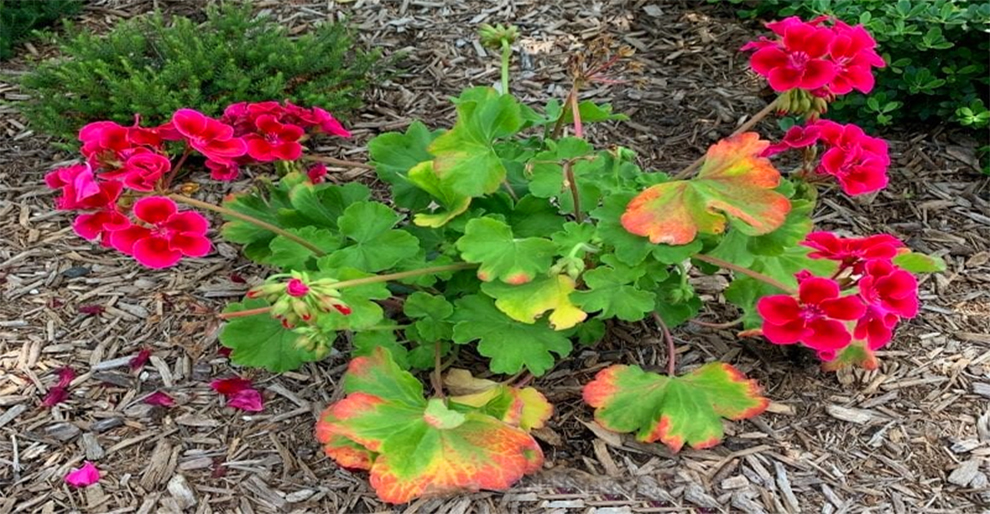
Insufficient sunlight can also be the reason for geraniums dying. Generally, geraniums seek at least six hours of direct sun daily to grow and thrive.
With adequate sunlight, the plant might become spindly and weak, with fewer leaves and long stems.
Further, the leaves may turn yellow and drop off, and the plant might not produce sufficient flowers.
How to fix it?
To fix this, move your plant to a sunnier location. Ideally, geraniums must be in an area that receives full sun, especially in the early afternoon and morning.
If the plant is indoors, move it near a south-facing window. But if you do not have natural sunlight coming into your house, you can install a grow light.
It is vital to note that if your plant has been in low light for an extended period, it may take some time to recover, even after being moved to a sunnier location.
D. Improper watering
Improper watering is another common reason that is often ignored but is majorly responsible for death in geraniums. Both underwatering and overwatering can be detrimental to your plant.
Overwatering can result in waterlogged soil, causing root rot and ultimately leading to plant death.
On the contrary, underwatering dries out the soil, preventing the plant from absorbing nutrients and water and resulting in stunted growth, wilting, and eventually death.
How to fix it?
To fix this issue, you must water the geraniums correctly. Water the plants only when the top inch of the soil feels dry on touch. Always water thoroughly, letting excess water drain from the pot.
Further, please know that the frequency and the amount of water may vary depending on the plant’s size, the environment where you plant the geranium, and the soil type.
E. Bacterial problems
Bacterial problems can also be the cause of death for geraniums. Bacterial infections might lead to stunted growth, wilting, yellowing leaves, and ultimately the plant’s death.
These infections usually occur when the plant is wounded or stressed, and bacteria enter via the wound.
Overwatering, overcrowding, and poor air circulation can all create a favorable environment for bacterial growth.
How to fix it?
To solve the problem, provide ample spacing between plants, ensuring they have space to grow and are not overcrowded.
Use well-draining soil and a container with drainage holes to avoid waterlogging. Further, do not overwater and let the soil dry out before you water again.
In addition, you must ensure that the geranium has good air circulation, as stagnant air is the root cause of bacterial growth.
If you notice any bacterial infection signs, such as brown or black spots on the stems or leaves, prune off the affected areas and destroy them to prevent them from spreading.
You can use a copper-based fungicide also to control the infection.
F. Fungal infection
Another prevalent cause of the death of geraniums is fungal infections. Fungi thrive in humid and damp conditions, resulting in problems like leaf spots, root rot, stem cankers, and damping off.
How to fix it?
There is no need to panic that ‘my geranium is dying.’ You have a simple solution here i.e. first and foremost to fix your watering schedule.
In addition, you must water the plant at the base. It helps prevent the water from splashing onto the leaves, a primary reason for fungal spores.
You can also better air circulation around the plant by spacing out the plants. Consider applying a fungicide to help keep fungal infections in check.
It is imperative to use a ant-fungal spray meant for plants to get rid of the infection.
G. Overuse of fertilizers
Overusing fertilizers can also adversely affect geraniums. Even though fertilizers are imperative for plant growth, applying excessive fertilizer can result in nutrient toxicity.
It may also cause salt build-up in the soil. Excessive salt in the soil causes the roots to become dehydrated.
Consequently, it is unable to absorb water. It may result in stunted growth and wilting and ultimately kill the plant.
How to fix it?
To combat this issue, use your fertilizers correctly by reading the instructions on the packaging label and not overapply them. Also, never fertilize when the plant is dormant or stressed.
After fertilizing, water the plant thoroughly to avoid salt build-up in the soil. Further, whenever you notice signs of fertilizer burn, such as crispy and brown leaf tips, lower the degree of fertilizing and increase watering to leach excess salt from the soil.
In some severe cases, repot the plant with fresh soil to eradicate all the surplus salt. Further, maintain a proper balance of nutrients in the soil to avoid fertilizer overuse and ensure healthy geranium growth.
H. Rusting
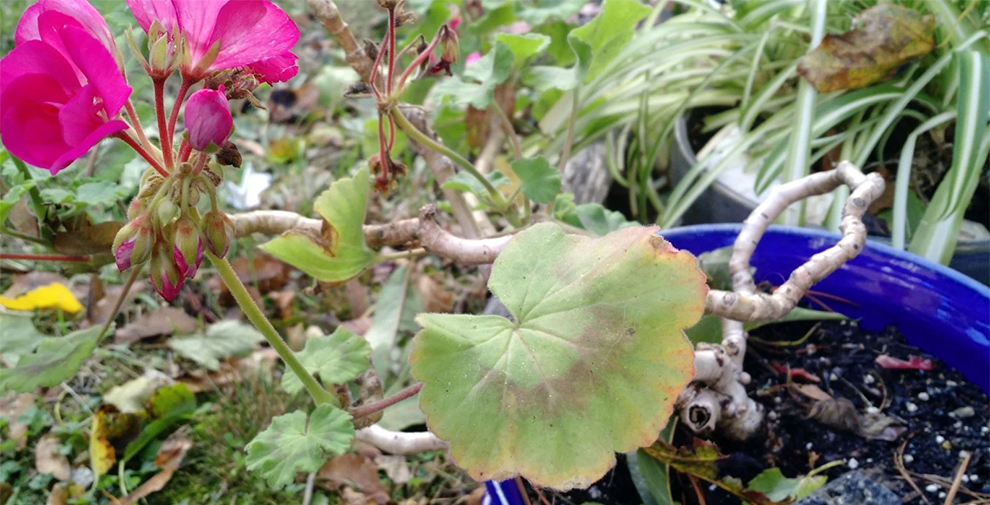
It is a prevalent fungal disease that affects geranium caused by Puccinia pelargonii-zonalis fungus. You will see it as a development of reddish-brown or brown rust spots on the stems and leaves of the plants.
As the disease progresses, the leaves become yellow and drop prematurely. Consequently, the plant’s overall health and growth may drop.
How to fix it?
Avoid overhead watering, as moisture on the leaves can promote rust fungus spores growth.
Instead, water the plant at the base. In addition, improving the air circulation around the plant by opening windows and spacing out the plants can also help. Further, apply a fungicide to overcome rust infections.
Further, remove all infected stems or leaves immediately and dispose of them to avoid the fungus spread. Act as you notice rust signs because rust spreads quickly and kills the plant.
We hope that next time you are worried and thinking, ‘My geraniums are dying. What could be the problem?’, you can assess the issue precisely and take steps to overcome it. May it be rusting or any other issue, you now know how to take care of it.
I. Leaf blight
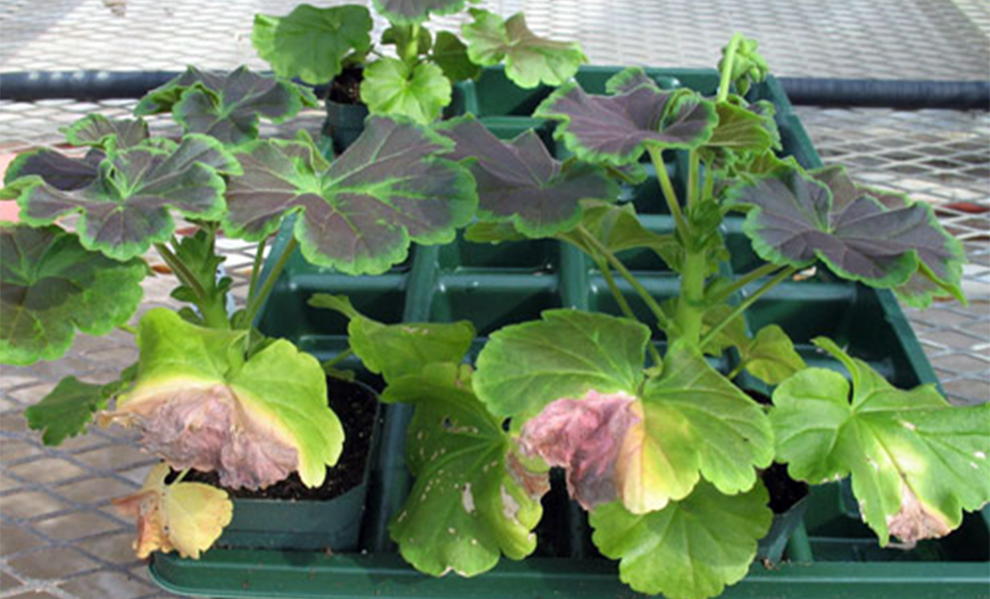
Caused by the Alternaria alternata fungus, Leaf Blight is another fungal disease that affects geranium. You will notice it with the development of dark brown, small spots on the leaves.
Over time, they may merge and enlarge, making the leaves turn yellow and die. In some cases, leaf blight might infect the stems, causing them to become dry and brown.
How to fix it?
Applying a fungicide can also help control leaf blight infections. You must promptly remove any infected leaves or stems and dispose of them to prevent the fungus from spreading.
You must also provide geraniums with good growing conditions and avoid overhead watering, as moisture on the leaves can promote fungal growth. Here is how to grow geraniums properly.
J. Pests like geranium sawflies, aphids & budworms
Sometimes pests can be responsible for plant death if left unchecked. The geranium sawfly is a caterpillar that feeds on the plant leaves, causing damage to the foliage.
Aphids are tiny insects that suck the sap from the plant, resulting in yellowing of the leaves and stunted growth.
Budworms are caterpillars that feed on the flowers and buds, resulting in deformities and damage to the blooms.
How to fix it?
If the infestation has occurred, use a neem oil or insecticidal soap to control and combat the infestations. However, be cautious and read the instructions carefully before applying.
You must never apply them in sunny weather. In addition, prune any heavily infested flowers or leaves and dispose of them to prevent the pests from spreading.
K. Extreme weather
Extreme weather conditions like cold temperatures, drought, or high heat can also be the reasons for geranium death.
Drought and high heat cause the geraniums to wither and dry out, whereas cold temperature damages the leaves and stems, resulting in root rot or plant death. In some cases, extreme weather can also make the plant susceptible to bacterial or fungal diseases.
How to fix it?
By providing your geraniums with proper care, you can guard them from extreme weather. Hence, regularly water geraniums and move them to a shade to avoid overheating during dry and hot weather.
On the contrary, when the temperature drops, you must guard the plant against freeze and frost damage by covering it with a frost blanket or moving it indoors if possible.
In addition, skip watering during cold weather, as wet soil may lead to root rot.
Related: How to care for geraniums in pots outside?
What Causes Holes In Geranium Leaves?
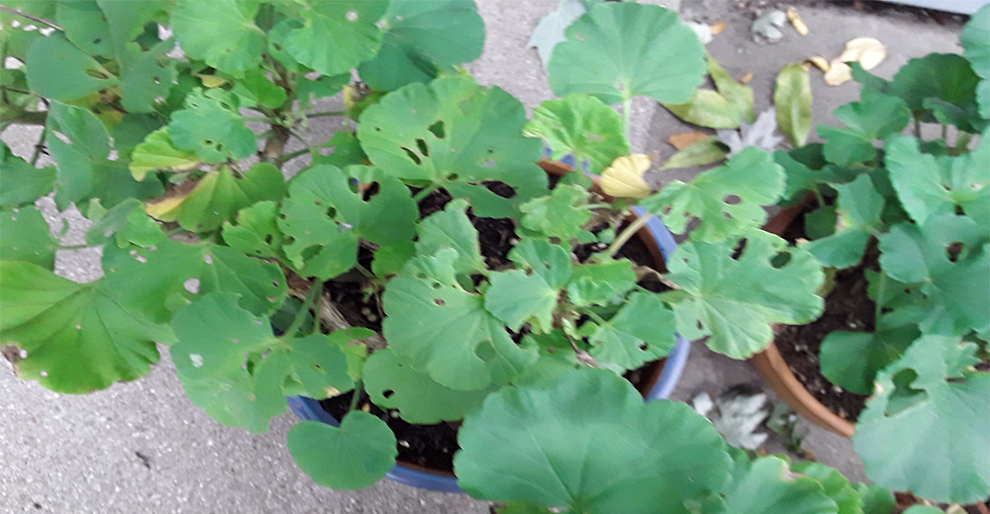
Several factors may lead to holes in the geranium leaves. These include:
- Insects, including caterpillars, beetles, and aphids, chew holes in the leaves, leaving them looking tattered or ragged.
- Diseases like fungal and bacterial leaf spots can also cause small, round holes in the leaves.
- Environmental stressors, such as extreme temperatures, drought, or excessive sun exposure, can also cause holes to form in geranium leaves.
These holes are irregularly shaped and accompanied by other symptoms such as yellowing or wilting.
What Is Wrong With My Geraniums – Signs Of A Dying Germanium!
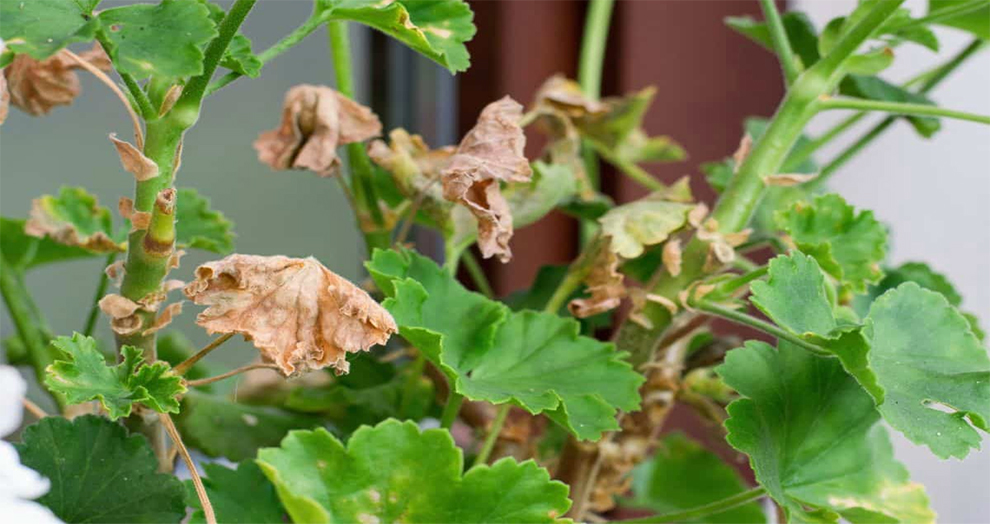
Here are some indications that your plant may be dying:
- No growth:If you see no new development or the plant has stopped growing, it could be a sign that your geranium is sick.
- Stunted growth:Sometimes geraniums might not grow as quickly as they should or may grow but not produce as many flowers.
- Discolored or crispy leaves: Yellow or brown dry and crispy leaves imply that your geranium is not receiving adequate water or has endured damage from diseases or pests.
- No flowers: At times, geranium might not produce any blooms. It could mean a lack of nutrients, overwatering, or root rot.
- Wilting or drooping: When geraniums do not get adequate water or are overwatered, they may become wilted. Further, wilting and drooping may indicate root damage or a pest or disease attack.
- Pest attack: Aphids, spider mites, and whiteflies are prevalent pests that infest geraniums. Watch for signs of sticky residue, webs, and tiny insects on the stems and leaves.
- No response to pruning: If you trimmed back your geraniums and it is not producing new growth, it may be too late to save your plant, as it is already dead.
- Rotting Roots: If the geranium roots appear to be rotting, it could be a sign of overwatering or poor soil drainage, which may eventually lead to your plant’s death.
How Do I Bring My Geraniums Back To Life After Reviving Them?
Reviving the geraniums is usually tricky. However, with the correct care, you can bring them to life, and they can thrive again.
Prune the dead parts of geranium and repot the plant. Further, follow a proper care regime. Use a well-draining potting mix and ensure the pot has drainage holes to avoid root rot.
Water only when the soil feels dry to touch, and do not let the soil become waterlogged.
Geraniums also need ample sunlight to thrive and a portion of balanced plant food with vital nutrients to grow and blossom.
